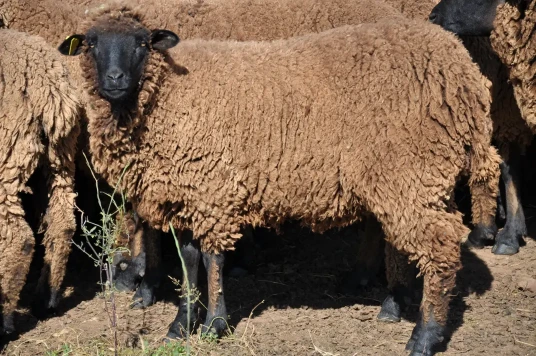Currently there are two varieties of Merino breed in danger of extinction officially recognized by the Ministry, Merino Black variety and Merino Montes Universales variety.
These two Merino varieties are recognized in different autonomous communities as endangered varieties. Forming part of the different regional RDPs (Rural Development Programs).
Black Merino Sheep
Culturally the superstitions of the shepherds directly affected this sheep, the newborn black Merino sheep were slaughtered. The history of shepherds drove them to be an endangered breed.
The fall in wool prices and properties of products derived from black Merino sheep created the marginal status of this breed. Its complicated dyeing condition, superstitions, religious aspects contributed to the sheep’s extinction situation. A variety that had once been a mainstay of the Spanish economy.
The Black Merino sheep breed has its largest population in Extremadura, Andalusia and Castilla León.
The native breed currently numbers 12,000 specimens and is an endangered species.
It was in November 1997 when the black Merino was finally recognized as an endangered variety of the Merino breed in the breed catalog. According to the Spanish Ministry of Agriculture, the black Merina is included in the specific regulations of the breed’s herd book, managed by the National Association of Merino Cattle Breeders. Since then it has become a nationally protected species.
This is not the end of the breed, there are new market niches to reverse the situation. The new interest in eco-fashion is one example. The textile industry has raised an interest in maintaining the species, clothes free of dyes, with a natural color and high quality. A great alternative to fast fashion. The quality of their wool is so great that the first herds that left Spain did so as royal gifts, says the National Association of Merino Cattle Breeders.
For them, without the benefits it would be impossible to maintain this activity, since neither in wool nor in meat production do they surpass the price of white sheep. Green fashion could be a lifesaver for this sector. A small but promising niche market for farmers.
Montes Universales Variety
The origin of this variety of the Merino breed is located in the Sierra de Albarracín, born with the transhumance and transhumance is a practice recognized since ancient times, as stated in the guide of the Transhumance Museum of Guadalaviar (Teruel): Julius Klein argues that the custom of biannual migrations dates back to the time of the Iberians, as the wandering shepherds assisted the Carthaginians in their marches across the Iberian Peninsula. This same author thinks that the Muslims contributed to the consolidation of the merina. “The Merino breed has predominated in the Sierra de Albarracín since the 15th century. Just like the churra tensina in the Pyrenees”. (Fernández Otal, 1996)
At present, the variety is found in the Sierra de Albarracín and extends in part of the Montes Universales in the provinces of Cuenca and Guadalajara.
At present, there are 6,000 specimens of this variety.
Very similar to the Merina breed without variety, more devoid of wool on the legs and head, due to the inclemency of the terrain. Its main quality is its hardiness, necessary to withstand hard trails to the extremes.
At present, the genetic reserve of the variety “Montes Universales”. In July 2016, the variety is officially recognized and cataloged as endangered. Thanks to this, the National Program for the conservation, improvement and promotion of livestock breeds was established. In addition, the Merina Montes Universales variety is included in the Merina sheep breed. Becoming a responsible breed of the National Association of Merino Cattle Breeders.

